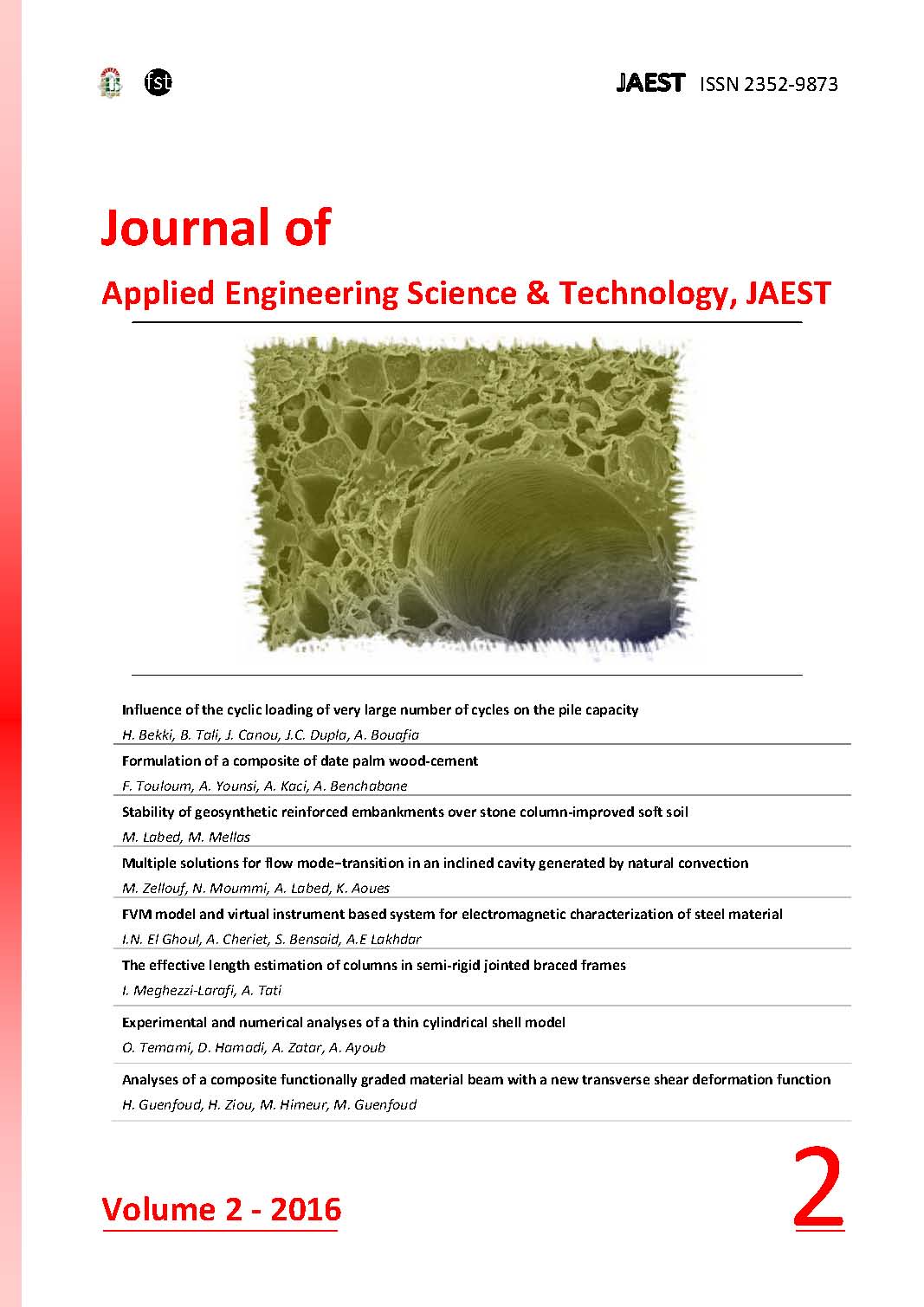DOI:
https://doi.org/10.69717/jaest.v2.i2.43Keywords:
Functionally Graded Material, Power-law, Finite Element Method, Timoshenko’s beam, Shear functionAbstract
In the present paper, we offer a higher-order shear deformation theory for bending of functionally graded beam. A new polynomial shear function is used which satisfies the stress-free boundary conditions (exact boundary conditions on the stress) at both, top and bottom surfaces of the beam. Hence, the shear correction factor is not necessary. Additionally, the present theory has strong similarities with Timoshenko beam theory in some concepts such as equations of movement, boundary conditions and stress resultant expressions. The governing equations and boundary conditions are derived from the principle of minimum potential energy. Functionally graded material FGM beams have a smooth variation of material properties due to continuous (unbroken) change in micro structural details. The variation of material properties is along the beam thickness and assumed to follow a power-law of the volume fraction of the constituents. Finite element numerical solutions obtained with the new polynomial shear function are presented and the obtained results are evaluated versus the existing solutions to verify the validity of the present theory. At last, the influences of power law indicator and the new shear deformation polynomial function on the bending of functionally graded beams are explored.
Downloads
Downloads
Published
Issue
Section
License

This work is licensed under a Creative Commons Attribution-NonCommercial 4.0 International License.
How to Cite
Similar Articles
- Farid Touloum, Akli Younsi, Abdelhak Kaci, Adel Benchabane, Formulation of a composite of date palm wood‐cement , Journal of Applied Engineering Science & Technology: Vol. 2 No. 2 (2016): JAEST
- Amar Rouag, Adel Benchabane, Adnane Labed, Nora Boultif, Thermal design of air cooled condenser of a solar adsorption refrigerator , Journal of Applied Engineering Science & Technology: Vol. 2 No. 1 (2016): JAEST
- Nadia Femmam, Said Mazouz, Analysis of legibility in urban public spaces. Case of El-Alia North-East neighborhood in Biskra, Algeria , Journal of Applied Engineering Science & Technology: Vol. 4 No. 2 (2018): JAEST
- Lamine Baci, Zakaria Boumerzoug, Claude Esnouf, Study of texture and recrystallization in commercial pure copper wire with and without heat treatment , Journal of Applied Engineering Science & Technology: Vol. 4 No. 2 (2018): JAEST
- Toufik Arrif1, Adel Benchabane, Abdelmadjid Chehhat, Abdelfetah Belaid, Amar Rouag, Numerical simulation of convective heat losses in a helical tube of a cylindrical solar receiver , Journal of Applied Engineering Science & Technology: Vol. 4 No. 2 (2018): JAEST
- Fatima-Zohra Lebbal, Said Mazouz, The effect of the patio on the indoor thermal performancein the colonial courtyard houses in the saharan climate. The case of Biskra in Algeria , Journal of Applied Engineering Science & Technology: Vol. 4 No. 1 (2018): JAEST
- Amel Aidi, Djamel Barkat, Extraction liquide-liquide du cobalt(II) par la N-(2-hydroxybenzylidene) aniline , Journal of Applied Engineering Science & Technology: Vol. 4 No. 1 (2018): JAEST
- Salah Zerguine, Djamel Benmeddour, Abdelhak Mabrouki, Bearing capacity of a strip footing on a geosynthetic reinforced soil modular block walls after a seismic loading , Journal of Applied Engineering Science & Technology: Vol. 4 No. 1 (2018): JAEST
- Hassiba Belaribi, Mekki Mellas, Using mathematical models and artificial neural networks for predicting the compressive strength of concrete with steel fibers exposed to high temperatures , Journal of Applied Engineering Science & Technology: Vol. 4 No. 1 (2018): JAEST
- Ouassila Bahloul, Khelifa Abbeche, Azeddine Bahloul, Study of the microstructure of collapsible soil treated with the potassium chloride , Journal of Applied Engineering Science & Technology: Vol. 2 No. 1 (2016): JAEST
You may also start an advanced similarity search for this article.





